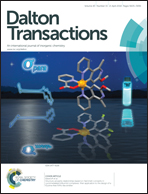Utility of tris(4-bromopyridyl) europium complexes as versatile intermediates in the divergent synthesis of emissive chiral probes†
Abstract
The synthetic utility of europium complexes with three coordinated 4-bromopyridyl groups for chromophore elaboration has been assessed in palladium-catalysed Sonogashira coupling reactions, and in copper(I) mediated click reactions of the triazide derivative, generated in situ. The crystal structure of the Eu complex of a p-OMe-phenyl substituted triazole at 100 K is reported in which the pendant triazole sensitising moieties interdigitate in the solid-state lattice. The triazole complex can be separated into Δ and Λ enantiomers by chiral HPLC but is weakly emissive in methanol (ε 5.5 mM−1 cm−1; λexc 320 nm; ϕ 0.2%), contrasting with a set of four alkynyl–aryl derivatives which are one thousand times brighter and absorb strongly with broad absorption maxima in the range 332 to 360 nm. An enantiopure europium complex gives an intense CPL signal in solution that is the strongest yet reported.


 Please wait while we load your content...
Please wait while we load your content...